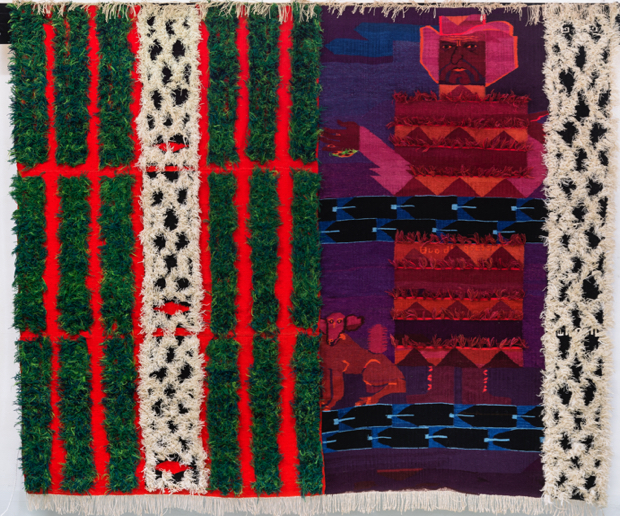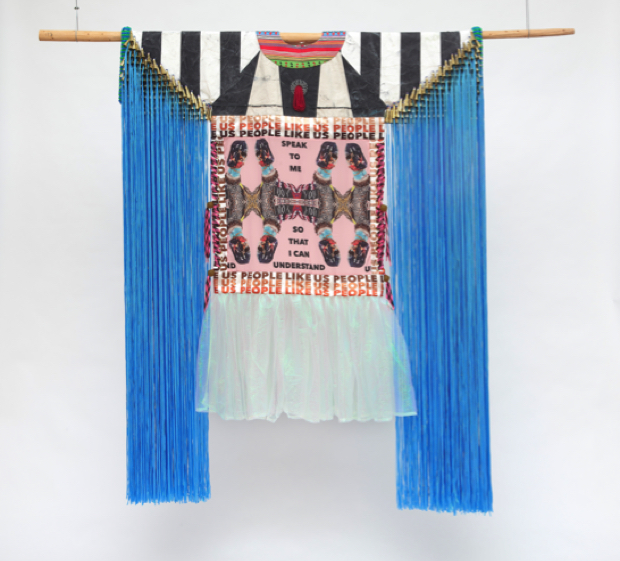Unravel: The Power and Politics of Textiles in Art Review ★★★★★
Teresa Margolles, american Juju for the Tapestry of Truth, 2015 (c) Courtesy of the artist and Galerie Peter Kilchmann, Zurich Paris
‘What does it mean to imagine a needle, a loom or a garment as tool of resistance?’ – that’s a question this exhibition poses and goes on to answer in full through an impressive collection of more than 100 pieces by 50 international practitioners arranged thematically and cross-culturally.
Over the years textile work has been mostly relegated to the inferior category of crafts, associated with female pastimes, and denied a place alongside other art forms from which women were excluded.As a young student in1980s Egypt’s Ghada Amer was not allowed to enrol in painting classes at art school because she was a woman.Undaunted, she produced Pink Landscape, a large canvas crisscrossed by lines of stitching that wouldn’t be out of place in any art gallery.
Amer’s work is on display in a section sub-titled ‘Subversive Stitch’.Together with the other sections – Bearing Witness, Wound and Repair, and Ancestral Threads, for example – it illustrates how textiles, essential for our everyday lives, have provided a potent medium for communicating and conveying messages.
Take ‘Bearing Witness’. Here Hannah Ryggen’s 1966 Blood in the Grass jumps at you as a forceful denunciation of the USA’s war in Vietnam.

Hannah Ryggen, Blood in the Grass, 1966
Equally powerful, Teresa Margolles’ handstitched work american Juju for the Tapestry of Truth (pictured top) commemorates the lives of individuals who were brutally killed.
Other pieces are more subtle.Arpilleras is a set of four small burlap squares stitched to depict village life in Chile under Pinochet’s dictatorship: one shows a sign calling villagers to a meeting to discuss problems with water and electricity provision.
Side by side with the anonymous Chilean villagers stand big names from the art world: Tracey Emin contributes a large appliqué blanket No Chance (WHAT A YEAR) marking a particularly harrowing year in her life; Judy Chicago a disturbing blood red silk embroidery, Birth Tear/Tear, Louise Bourgeois Arch of Hysteria, a small hanging roughly stitched together human figure.
The exhibition starts on the top level, with the lower level dedicated to massive, colourful installations. Jeffrey Gibbon draws on his Choctaw/Cherokee heritage to produce richly detailed pieces shown hanging from the ceiling.

Jeffrey Gibson, SPEAK TO ME SO THAT I CAN UNDERSTAND, 2018 (c) Jeffrey Gibson Courtesy of Sunderland-Cohen Collection
Cecilia Vicuña, whose work was recently featured in the Turbine Hall at Tate Modern, has a stunning display of lengths of orange, yellow and red unspun wool hanging from the ceiling and pooling on the ground, like a colourful forest, animated by the soft sound of her voice chanting poems related to water.
There is work from Africa – I was particularly enchanted by South African Igshaan Adams's ineffable hangings of prayer clouds – and from Asia, for example, Mrinalini Mukherjee’s larger than life macramé sculptures.
I learnt, too, that at one point in the history of empire, one length of indigo dyed cotton was considered to have the same economic value as a slave.The textiles we take for granted carry a multifarious history of repression and resistance, challenge and transgression, all graphically illustrated in this glorious exhibition.
Over the years textile work has been mostly relegated to the inferior category of crafts, associated with female pastimes, and denied a place alongside other art forms from which women were excluded.As a young student in1980s Egypt’s Ghada Amer was not allowed to enrol in painting classes at art school because she was a woman.Undaunted, she produced Pink Landscape, a large canvas crisscrossed by lines of stitching that wouldn’t be out of place in any art gallery.
Amer’s work is on display in a section sub-titled ‘Subversive Stitch’.Together with the other sections – Bearing Witness, Wound and Repair, and Ancestral Threads, for example – it illustrates how textiles, essential for our everyday lives, have provided a potent medium for communicating and conveying messages.
Take ‘Bearing Witness’. Here Hannah Ryggen’s 1966 Blood in the Grass jumps at you as a forceful denunciation of the USA’s war in Vietnam.

Hannah Ryggen, Blood in the Grass, 1966
Equally powerful, Teresa Margolles’ handstitched work american Juju for the Tapestry of Truth (pictured top) commemorates the lives of individuals who were brutally killed.
Other pieces are more subtle.Arpilleras is a set of four small burlap squares stitched to depict village life in Chile under Pinochet’s dictatorship: one shows a sign calling villagers to a meeting to discuss problems with water and electricity provision.
Side by side with the anonymous Chilean villagers stand big names from the art world: Tracey Emin contributes a large appliqué blanket No Chance (WHAT A YEAR) marking a particularly harrowing year in her life; Judy Chicago a disturbing blood red silk embroidery, Birth Tear/Tear, Louise Bourgeois Arch of Hysteria, a small hanging roughly stitched together human figure.
The exhibition starts on the top level, with the lower level dedicated to massive, colourful installations. Jeffrey Gibbon draws on his Choctaw/Cherokee heritage to produce richly detailed pieces shown hanging from the ceiling.

Jeffrey Gibson, SPEAK TO ME SO THAT I CAN UNDERSTAND, 2018 (c) Jeffrey Gibson Courtesy of Sunderland-Cohen Collection
Cecilia Vicuña, whose work was recently featured in the Turbine Hall at Tate Modern, has a stunning display of lengths of orange, yellow and red unspun wool hanging from the ceiling and pooling on the ground, like a colourful forest, animated by the soft sound of her voice chanting poems related to water.
There is work from Africa – I was particularly enchanted by South African Igshaan Adams's ineffable hangings of prayer clouds – and from Asia, for example, Mrinalini Mukherjee’s larger than life macramé sculptures.
I learnt, too, that at one point in the history of empire, one length of indigo dyed cotton was considered to have the same economic value as a slave.The textiles we take for granted carry a multifarious history of repression and resistance, challenge and transgression, all graphically illustrated in this glorious exhibition.
TRY CULTURE WHISPER
Receive free tickets & insider tips to unlock the best of London — direct to your inbox
| What | Unravel: The Power and Politics of Textiles in Art Review |
| Where | Barbican Centre, Silk Street, London, EC2Y 8DS | MAP |
| Nearest tube | Barbican (underground) |
| When |
13 Feb 24 – 26 May 24, 10:00 Late opening Thurdays |
| Price | £18 |
| Website | https://www.barbican.org.uk/whats-on/2024/event/unravel-the-power-and-politics-of-textiles-in-art |